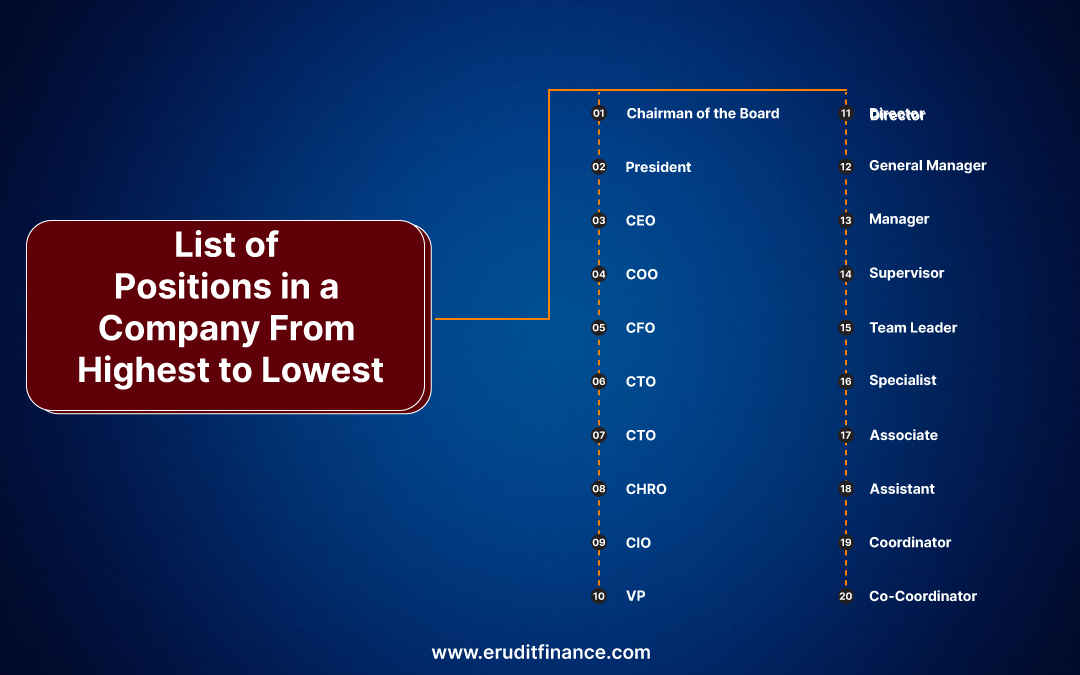
The designation of a company refers to the titles or roles given to the individuals who hold positions of authority and responsibility within the organization. The list of Designations in a Company can vary depending on the company’s structure, size, and industry. Some common designations in a company include CEO (Chief Executive Officer), COO (Chief Operating Officer), CFO (Chief Financial Officer), CTO (Chief Technology Officer), CMO (Chief Marketing Officer), and CHRO (Chief Human Resources Officer).
Other designations may include managers, supervisors, team leaders, and various executive positions. These titles are often used to provide a clear understanding of an individual’s responsibilities, authority, and level within the organization. They can also help employees understand the hierarchy of the company and who to report to for specific issues.
Let’s Dive In!
List of Designations in a Company
The list of designations in a company can vary depending on the organization’s size, structure, and industry. However, here is a general list of some common designations found in companies.
| GM | CHRO | Supervisor | Executive Assistant |
| VP | CISCO | IT Manager | Operations Manager |
| CFO | CTO | Team Leader | Marketing Manager |
| CEO | CIO | HR Manager | Business Analyst |
| CMO | COO | Sales Manager | Project Manager |
| Director | Accountant | Finance Manager | IT Support Specialist |
| Manager | Receptionist | Marketing Coordinator | Sales Representative |
Again, this is not an exhaustive list and titles can vary depending on the organization.
Job Functions Examples (List of Designations in a Company)

Top-Level Management
- CEO (Chief Executive Officer): Responsible for the overall strategic direction and management of the company.
- COO (Chief Operating Officer): Responsible for the day-to-day operations of the company.
- CFO (Chief Financial Officer): Responsible for managing the company’s finances, financial planning, and reporting.
- CTO (Chief Technology Officer): Responsible for managing the company’s technology resources and ensuring that the technology is aligned with the company’s goals.
- CMO (Chief Marketing Officer): Managed the company’s marketing efforts, including advertising, public relations, and market research.
- CHRO (Chief Human Resources Officer): Responsible for managing the company’s human resources, including recruiting, hiring, training, and benefits.
- CIO (Chief Information Officer): Responsible for managing the company’s information technology and computer systems.
- CISO (Chief Information Security Officer): Responsible for managing the company’s information security and ensuring that the company’s data is protected.
- General Manager: Responsible for managing a specific department or business unit within the company.
- Vice President (VP): Typically responsible for a specific area of the company, such as sales, marketing, finance, or operations.
- Director: Responsible for managing a specific department or team within the company.
Middle-Level Management
- Manager: Responsible for managing a team of employees and ensuring that they meet their goals and objectives.
- Supervisor: Responsible for overseeing a team of employees and ensuring that they follow company policies and procedures.
- Team Leader: Responsible for leading a team of employees and ensuring that they work together effectively.
- Sales Manager: Responsible for managing the company’s sales team and ensuring that they meet their sales targets.
- Marketing Manager: Responsible for managing the company’s marketing efforts and ensuring that they are aligned with the company’s goals.
- Operations Manager: Responsible for managing the day-to-day operations of the company, including production, logistics, and supply chain management.
- Finance Manager: Responsible for managing the company’s financial resources and ensuring that the company’s financial goals are met.
- HR Manager: Responsible for managing the company’s human resources, including recruiting, hiring, and training.
- IT Manager: Responsible for managing the company’s information technology and ensuring that the technology is aligned with the company’s goals.
- Project Manager: Responsible for managing specific projects within the company and ensuring that they are completed on time and within budget.
- Business Analyst: Responsible for analyzing business processes and identifying areas for improvement.
- Accountant: Responsible for managing the company’s financial records and preparing financial statements.
Lower-Level Management
- Executive Assistant: Responsible for providing administrative support to senior executives within the company.
- Receptionist: Responsible for greeting visitors and answering incoming calls.
- Administrative Assistant: Responsible for providing administrative support to various departments within the company.
- Customer Service Representative: Responsible for answering customer inquiries and resolving customer issues.
- Sales Representative: Responsible for selling the company’s products or services to customers.
- Marketing Coordinator: Responsible for coordinating the company’s marketing efforts, including advertising and promotional campaigns.
- IT Support Specialist: Responsible for providing technical support to employees who have issues with their computers or software.
List of Positions in a Company, from Highest to Lowest
The order of positions in a company from highest to lowest can vary depending on the company’s size, industry, and structure.

| Ceo | CFO | President | Manager | Associate |
| CIO | CTO | Chairman Of Board | Supervisor | Assistant |
| VP | CMO | Director | Team Leader | Coordinator |
| COO | CHRO | General Manager | Specialist | Co-Coordinator |
Again, this is not an exhaustive list and titles can vary depending on the organization. Additionally, it is important to note that in some companies, the order of positions may not necessarily correspond to the level of authority or responsibility.
HR Position Titles
Human resources (HR) departments have a variety of positions with varying levels of responsibility and experience required. Here are some common HR position titles:

| A). Chief HR Officer | K). HR Information Systems Manager |
| B). Vice President of HR | L). HR Operations Manager |
| C). HR Director | M). Diversity & Inclusion Specialist |
| D). HR Manager | N). HR Generalist |
| E). Talent Acquisition Manager | O). Payroll Manager |
| F). Recruitment Coordinator | P). HR Coordinator |
| G). HR Business Partner | Q). Benefits Coordinator |
| H). Training & Development Manager | R.) HR Administrator |
| I). Compensation & Benefits Manager | S). HR Assistant |
| J). Employee Relations Specialist | T). HR Intern |
Again, it’s important to note that the specific HR titles and responsibilities can vary between companies and industries.
What are the Highest-Ranking Positions in Company?
The highest-ranking positions in a company typically include the following:

- Chairman of the Board: This position is the highest-ranking position in a company’s board of directors, responsible for overseeing the board and providing strategic guidance to the company.
- Chief Executive Officer (CEO): The CEO is responsible for the overall direction and strategy of the company, as well as managing the company’s day-to-day operations.
- President: The president is responsible for managing the company’s overall operations and ensuring that the company achieves its goals and objectives.
- Chief Operating Officer (COO): The COO is responsible for the day-to-day operations of the company, including overseeing production, logistics, and supply chain management.
- Chief Financial Officer (CFO): The CFO is responsible for managing the company’s financial resources, including financial planning, reporting, and risk management.
- Chief Technology Officer (CTO): The CTO is responsible for managing the company’s technology resources and ensuring that the company’s technology is aligned with its goals.
- Chief Marketing Officer (CMO): The CMO is responsible for managing the company’s marketing efforts, including advertising, public relations, and market research.
- Chief Human Resources Officer (CHRO): The CHRO is responsible for managing the company’s human resources, including recruiting, hiring, training, and benefits.
- Chief Information Officer (CIO): The CIO is responsible for managing the company’s information technology and computer systems.
It’s important to note that the order and number of positions can vary depending on the company’s size, industry, and structure. Additionally, some companies may have additional executive positions beyond those listed above.
Sales and Marketing Designations List
Sales:
| Sales Leadership | Direct Sales | Indirect Sales | Support & Operations |
| 1). Chief Sales Officer (CSO)
2). Vice President of Sales (VP Sales) 3). Regional Sales Director 4). Sales Manager 5). Territory Manager 6). District Manager |
1). Account Executive (AE)
2). Business Development Representative (BDR) 3). Inside Sales Representative (ISR) 4). Customer Success Manager (CSM) 5). Account Manager (AM) 6). Sales Engineer 7). Solutions Consultant |
1). Channel Account Manager (CAM) 2). Partnership Manager 3). Alliance Manager 4). Distributor Account Manager |
1). Sales Operations Manager
2). Customer Support Representative (CSR) 3). Technical Support Specialist 4). Sales Analyst |
Marketing:
| Marketing Leadership | Brand & Creative | Content & Social Media | Digital Marketing | Product Marketing | Market Research |
| 1). Chief Marketing Officer (CMO)
2). Vice President of Marketing (VP Marketing) 3). Director of Marketing 4). Brand Director 5). Marketing Manager 6). Product Marketing Manager |
1). Brand Manager
2). Creative Director 3). Copywriter 4). Graphic Designer 5). User Experience (UX) Designer 6). Video Editor |
1). Content Marketing Manager
2). Social Media Manager 3). Content Creator 4). Community Manager 5). SEO Specialist |
1). Digital Marketing Manager
2). Paid Search Specialist (PPC) 3). Search Engine Optimization (SEO) Specialist 4). Email Marketing Specialist 5). Analytics Specialist |
1). Product Marketing Manager
2). Product Marketing Specialist 3). Competitive Analyst 4). Product Evangelist |
1). Market Research Analyst
2). Competitive Intelligence |
Other Important Positions
- Marketing Operations Manager
- Public Relations (PR) Specialist
- Event Marketing Manager
- Business Development Manager
- Marketing Analyst
Remember: This list is not exhaustive, and specific titles and functions can vary depending on the company, industry, and size. However, it provides a good starting point for understanding the typical landscape of sales and marketing designations.
Frequently Asked Questions(FAQs)
What Position Comes After Supervisor?
The position that typically comes after a Supervisor is a Manager. A Manager is responsible for overseeing the work of supervisors and employees and is generally responsible for achieving departmental or organizational goals. Depending on the organization, there may be several levels of management positions, with titles such as Senior Manager, Director, or General Manager. These positions usually have increasing levels of responsibility and authority compared to a Supervisor.
Closing Up
Hopefully, You understand all the points of the List of Designations in a Company. We tried to cover almost all the points. Comment Down your queries below.
Thank You
Recommended Articles











Great post! I never realized there were so many different designations in a company. I learned a lot from this post and will definitely keep it in mind for future reference. Thanks for sharing!
Wow, I didn’t expect to see such a comprehensive list of designations in a company! As a job seeker, this information is super valuable. I’ve learned a lot from this post already, thanks for sharing!
Wow, this is so informative! I had no idea there were so many designations in a company. Thank you for compiling this list, I’ll definitely be referring back to it often.
I really found this post informative and helpful in understanding the different designations within a company. The list covered a good range of positions and was easy to follow. Thank you for sharing!
Thanks for magnificent info I was looking for this info for my mission.
Thanks for sharing your knowledge on this topic. It’s much appreciated.
I found this article to be very eye-opening. Thanks for sharing.
This is a topic I’ve been curious about. Thanks for the detailed information.
This post is super helpful! It’s interesting to see the variety of designations and roles within a company. It really highlights how each position contributes to the overall success of the organization. Thanks for sharing!
Great list! It’s interesting to see the variety of roles within a company and how each position contributes to the overall success. I’ve learned a lot about the different designations. Thanks for sharing!
Nice i really enjoyed reading your blogs. Keep on posting. Thanks
Nice i really enjoyed reading your blogs. Keep on posting. Thanks
Thank you for sharing indeed great looking !
Thank you for sharing indeed great looking !
The information shared is of top quality which has to get appreciated at all levels. Well done…
Nice i really enjoyed reading your blogs. Keep on posting. Thanks
A great post without any doubt.
Thank you so much for sharing this wonderful post with us.
Nice i really enjoyed reading your blogs. Keep on posting. Thanks
Nice i really enjoyed reading your blogs. Keep on posting. Thanks
The information shared is of top quality which has to get appreciated at all levels. Well done…
Nice i really enjoyed reading your blogs. Keep on posting. Thanks
I have been exploring for a bit for any high quality articles or blog posts in this sort of area . Exploring in Yahoo I eventually stumbled upon this website. Reading this info So i’m happy to express that I have an incredibly good uncanny feeling I came upon exactly what I needed. I most surely will make sure to don’t forget this site and give it a glance regularly.
A great post without any doubt.
Thank you so much for sharing this wonderful post with us.
Thank you so much for sharing this wonderful post with us.
Thank you so much for sharing this wonderful post with us.
Nice i really enjoyed reading your blogs. Keep on posting. Thanks
A great post without any doubt.
Thank you for sharing indeed great looking !
Thank you for sharing indeed great looking !
Nice i really enjoyed reading your blogs. Keep on posting. Thanks
A great post without any doubt.
Thank you so much for sharing this wonderful post with us.
The information shared is of top quality which has to get appreciated at all levels. Well done…
Thank you so much for sharing this wonderful post with us.
I was able to find good information from your blog articles.
Thank you so much for sharing this wonderful post with us.
I’m extremely pleased to uncover this website. I wanted to thank you for your time just for this wonderful read!! I definitely liked every little bit of it and I have you saved as a favorite to look at new stuff in your website.
Thank you for sharing indeed great looking !
It’s hard to find well-informed people on this topic, however, you sound like you know what you’re talking about! Thanks
Thankfulness to my father who told me regarding this website, this webpage is really awesome.|
I am no longer certain the place you’re getting your info, however good topic. I must spend a while learning much more or figuring out more. Thank you for fantastic information I used to be searching for this information for my mission.
This post sparks important conversations, encouraging readers to think critically about the topic.
This is a very informative post! It’s interesting to see the variety of designations within a company and how each role contributes to the overall success of the organization. I didn’t realize there were so many distinct positions! Thank you for sharing this!
A great post without any doubt.
Hello there! This post couldn’t be written any better! Reading through this post reminds me of my previous room mate! He always kept talking about this. I will forward this article to him. Fairly certain he will have a good read. Many thanks for sharing!
This list is incredibly helpful! It’s interesting to see the variety of positions within a company and how each role contributes to the overall success. I especially appreciate the brief descriptions for each designation; they really clarify the responsibilities associated with each position. Great read!
This post is super helpful! It’s interesting to see all the different roles and how they fit into the overall structure of a company. I never realized there were so many designations. Great breakdown!
This is a really informative post! I love how you’ve clearly outlined different designations within a company. It’s great for people who are starting their careers or considering a job change. Thanks for sharing!
Great post! It’s really helpful to see a clear list of company designations and their roles. It gives insight into how different positions contribute to the organization. Thanks for sharing!
Great breakdown of company designations! It’s really helpful to see the variety of roles and how they fit into the overall structure. This list provides a solid overview for anyone curious about corporate hierarchies. Thanks for sharing!
Hello there, I found your blog via Google whilst searching for a related topic, your web
site got here up, it seems great. I’ve bookmarked it in my google
bookmarks.
Hello there, simply changed into alert to your blog via Google, and located that it’s
really informative. I’m gonna be careful for brussels.
I’ll be grateful when you proceed this in future. A lot of
other folks will be benefited out of your writing.
Cheers!
Thanks for breaking down IL in such a simple way.
This list of designations is really helpful, especially for someone looking to understand the structure of a company. It’s interesting to see the variety of roles and how they contribute to overall operations. Thank you for sharing this comprehensive overview!
Great list! It’s really helpful to have a clear understanding of the various designations in a company. This will definitely aid in navigating the corporate landscape. Thanks for compiling this!
This list of designations is incredibly helpful! It clarifies the roles and hierarchy within a company, making it easier to understand how different positions contribute to the overall success. Great resource for anyone looking to navigate the corporate world!
This post is super helpful! I love the way you’ve outlined the different designations, especially the brief descriptions. It’s a great resource for anyone trying to understand company structures better. Thanks for sharing!
Great post! It’s really helpful to see a comprehensive list of designations in a company. It gives clarity on the roles and responsibilities within an organization. I particularly found the explanation of each position valuable. Thanks for sharing!
Great amazing blog
Great post! I never realized there were so many different designations in a company.
Thanks for sharing this comprehensive list of designations! It’s really helpful for understanding the hierarchy and roles within a company. I appreciated the brief descriptions for each position – it makes it easier to grasp what each role entails. Great job!
Great amazing blog
Your writing doesn’t try to impress; it connects. That’s why it resonates so deeply with so many people.